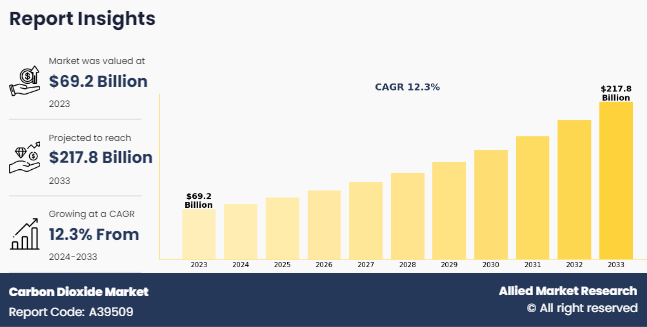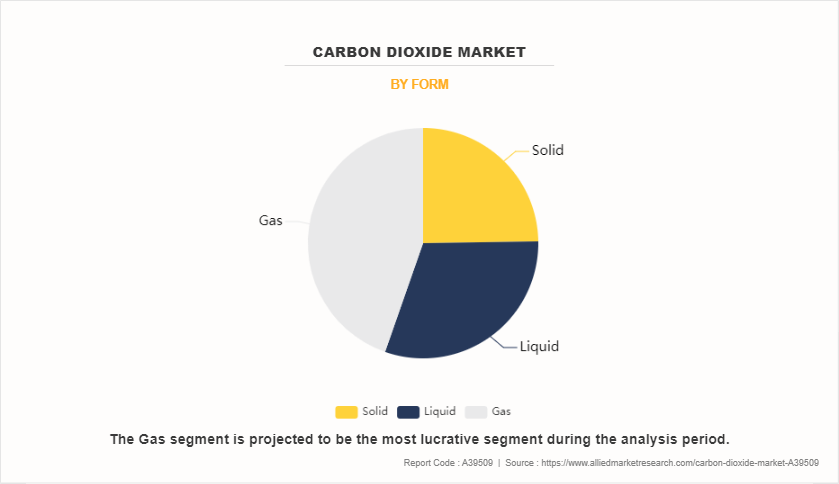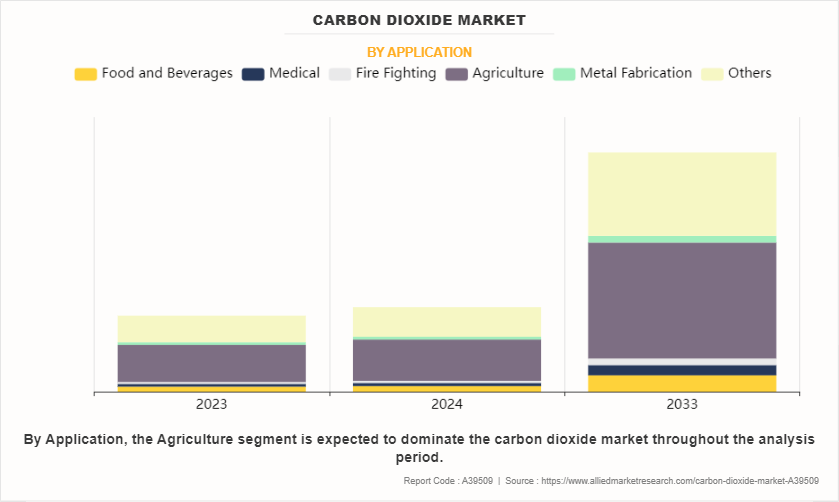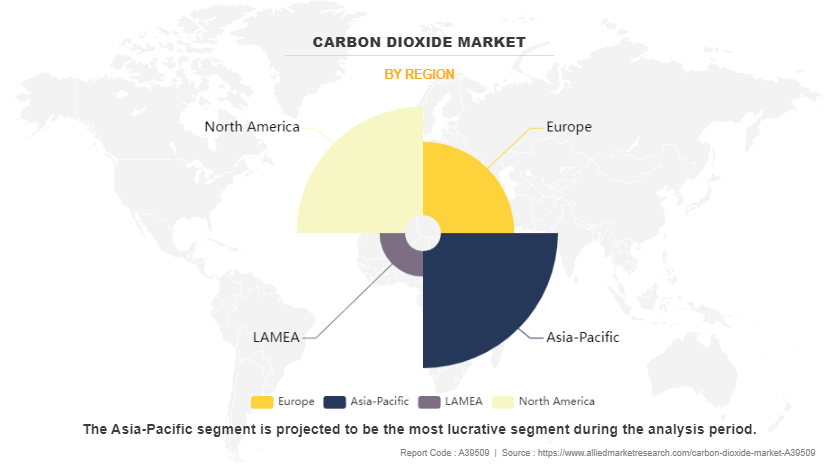Carbon Dioxide Market Research, 2033
The global carbon dioxide market size was valued at $69.2 billion in 2023, and is projected to reach $217.8 billion by 2033, growing at a CAGR of 12.3% from 2024 to 2033. The carbon dioxide industry is driven by its widespread applications across industries such as food and beverages, agriculture, healthcare, and manufacturing. With growing demand for enhanced crop yield, food preservation, and industrial processes, the market continues to expand, supported by advancements in technology and increasing focus on sustainability and resource efficiency.
Introduction
Carbon dioxide (CO2) is a colorless, odorless gas naturally present in Earth’s atmosphere as part of the carbon cycle. Comprising one carbon atom and two oxygen atoms (CO2), it is produced through natural processes such as respiration, volcanic eruptions, and decomposition, as well as human activities such as burning fossil fuels and industrial processes. While essential for photosynthesis in plants, which convert CO2‚ into oxygen, excess CO2‚ from human activities is a major greenhouse gas contributing to global warming. CO2‚ is widely used in carbonated beverages, refrigeration, and enhanced oil recovery.

Key Takeaways
- Quantitative information mentioned in the Carbon dioxide market includes the market numbers in terms of value ($Billion) and volume concerning different segments, annual growth rate, CAGR (2024-33), and growth analysis.
- The analysis in the carbon dioxide market report is provided based on end-use. The study is expected to contain qualitative information such as the market dynamics (drivers, restraints, opportunities), Porter’s Five Force Analysis, key regulations across the region, and value chain analysis.
- A few companies Ellenbarrie industrial Gases, Gulfcryo, Dubai Industrial Gas, Buzwair Industrial Gases Factories, ACAIL GÁS, Linde PLC, Messer Group, SOL SpA, and TAIYO NIPPON SANSO CORPORATION hold a large proportion of the carbon dioxide Market.
- This report makes it easier for existing market players and new entrants to the Carbon Dioxide Industry to plan their strategies and understand the dynamics of the industry, which helps them make better decisions.
Market Dynamics
Rise in demand for Carbon Capture and Storage (CCS) technologies is a key driver in the growth of the market in Carbon Dioxide Industry. CCS involves capturing CO2‚ emissions from industrial sources, such as power plants and manufacturing facilities, and transporting it to be stored underground or reused, reducing atmospheric emissions. This demand is fueled by increased regulatory pressure to lower greenhouse gas emissions and limit climate impact, as well as incentives for companies to adopt eco-friendly solutions. The surge in investment in CCS infrastructure, combined with advancements in technology, supports expanded CO2 capture and storage capacities, driving market growth and aiding sustainability goals. All these factors are expected to drive the growth of the carbon dioxide market during the forecast period.
However, environmental and safety concerns significantly hinder the growth of the carbon dioxide market. While CO2 is essential in various industrial processes, its storage, transportation, and usage pose risks, such as leakage or contamination. High concentrations of CO2 can be hazardous to human health, leading to strict safety protocols and regulations. In addition, the environmental impact of large-scale CO2 capture and storage (CCS) projects raises concerns about potential leakage from underground storage sites, which could contribute to groundwater contamination or exacerbate environmental issues. These safety and environmental challenges increase operational costs and slow the widespread adoption of CO2 technologies. All these factors hamper the carbon dioxide market growth.
The increasing demand for CO2 in Enhanced Oil Recovery (EOR) presents a significant opportunity for the carbon dioxide market. EOR is a method used to extract additional oil from mature and declining oil fields by injecting CO2 into underground reservoirs, which helps to reduce oil viscosity and increase production rates. As global oil reserves mature, the need for EOR technologies grows, driving the demand for CO2. This creates a market for capturing, transporting, and injecting CO2 into oil fields, opening opportunities for companies to provide CO2 and related infrastructure solutions, contributing to both oil recovery and CO2 management. All these factors are anticipated to offer new growth opportunities for the carbon dioxide market forecast.
Segment Overview
The carbon dioxide market is segmented into form, application, and region. On the basis of form, the market is classified into solid, liquid, and gas. On the basis of application, the market is classified into food and beverages, medical, firefighting, agriculture, metal fabrication, and others. Region-wise, the market is analyzed across North America, Europe, Asia-Pacific, and LAMEA.

Carbon Dioxide Market, by Type
In 2023, the gas segment held the highest carbon dioxide market share. This is due to its widespread use in various industries, including food and beverages, healthcare, and manufacturing. CO2 in gas form is essential for carbonation, refrigeration, and as a propellant in products such as fire extinguishers. Its versatility, ease of transport, and cost-effectiveness contributed to its leading market share, meeting the growing demand for industrial and commercial applications. Solid, with a projected 12.5% CAGR from 2024 to 2033, are growing rapidly due to increasing demand in sectors such as food preservation, healthcare, and industrial applications, coupled with advancements in carbon capture technologies.

Carbon Dioxide Market, by Application
In 2023, the agriculture segment held the largest carbon dioxide market size. This growth is due to its crucial role in enhancing plant growth. CO2 is used in controlled environment agriculture, such as greenhouses, to accelerate photosynthesis and boost crop yields. The increasing demand for food production, coupled with the adoption of advanced agricultural practices and technologies, further drove the market's growth in this sector, making it the largest contributor to CO2‚ consumption. The medical segment is expected to grow at the highest CAGR due to increasing demand for CO2‚ in medical applications like respiratory therapies, cryotherapy, and medical imaging.

Carbon Dioxide Market, by Region
The Asia-Pacific region dominates the carbon dioxide market and is expected to witness the highest compound annual growth rate (CAGR) of 12.6% from 2024 to 2033. This growth is driven by rapid industrialization, increasing demand for CO2‚ in sectors like food and beverages, healthcare, and enhanced oil recovery. Additionally, government initiatives promoting sustainable practices and infrastructure development, coupled with a growing focus on carbon capture technologies, are further fueling market expansion in this region.
Competitive Analysis
The key players operating in the carbon dioxide market are Ellenbarrie industrial Gases, Gulfcryo, Dubai Industrial Gas, Buzwair Industrial Gases Factories, ACAIL GÁS, Linde PLC, Messer Group, SOL SpA, and TAIYO NIPPON SANSO CORPORATION.
Key Benefits For Stakeholders
- The study provides an in-depth analysis of the market with current and future carbon dioxide market trends to elucidate the imminent investment pockets.
- Information regarding key drivers, restraints, and opportunities along with their impact on the carbon dioxide market analysis is provided in the report.
- Porter's five forces analysis illustrates the potency of buyers and suppliers operating in the carbon dioxide industry.
- The quantitative analysis of the Carbon Dioxide Market from 2023 to 2033 is provided to determine the market potential.
Carbon Dioxide Market, by Form Report Highlights
| Aspects | Details |
| Market Size By 2033 | USD 217.8 billion |
| Growth Rate | CAGR of 12.3% |
| Forecast period | 2023 - 2033 |
| Report Pages | 389 |
| By Form |
|
| By Application |
|
| By Region |
|
| Key Market Players | India Glycols Limited, Dubai Industrial Gas, TAIYO NIPPON SANSO CORPORATION, Buzwair Industrial Gases Factories, ACAIL GAS, Linde PLC, Gulfcryo, Ellenbarrie industrial Gases, SOL SpA, Messer Group |
Analyst Review
According to the opinions of various CXOs of leading companies, the carbon dioxide market is expected to witness an increase in demand during the forecast period. The carbon dioxide (CO?) market has experienced robust growth, fueled by the food and beverage industry's increasing demand for CO? in applications such as carbonation, food preservation, and modified atmosphere packaging (MAP). CO? is essential for carbonating beverages, extending shelf life, and maintaining food quality in packaged goods. This demand has surged as industry expands and consumer preferences evolve toward products with extended freshness and unique textures, such as carbonated juices and craft sodas.
Moreover, the increase in adoption of carbon capture and storage (CCS) technologies plays a pivotal role in reducing industrial emissions. CCS technology captures CO? emissions from power plants and industrial sources, preventing the greenhouse gas from getting released into the atmosphere. After capture, the CO? is stored underground or utilized in applications such as enhanced oil recovery, construction materials, and chemical production. This mitigates the environmental impact and supports the transition to a circular economy, aligning with global net-zero emissions goals and adding momentum to the carbon dioxide market growth.
$217.8 billion is the estimated industry size of carbon dioxide in 2033.
Expanding use of CO2 in agriculture and chemical applications are the upcoming trends of Carbon Dioxide Market in the globe.
Agriculture is the leading application of Carbon Dioxide Market in 2023.
Asia-Pacific is the largest regional market for carbon dioxide in 2023.
Ellenbarrie industrial Gases, Gulfcryo, Dubai Industrial Gas, Buzwair Industrial Gases Factories, ACAIL GÁS, Linde PLC, Messer Group, SOL SpA, and Taiyo Nippon Sanso Corporation are the top companies to hold the market share in Carbon Dioxide.
Loading Table Of Content...
Loading Research Methodology...



